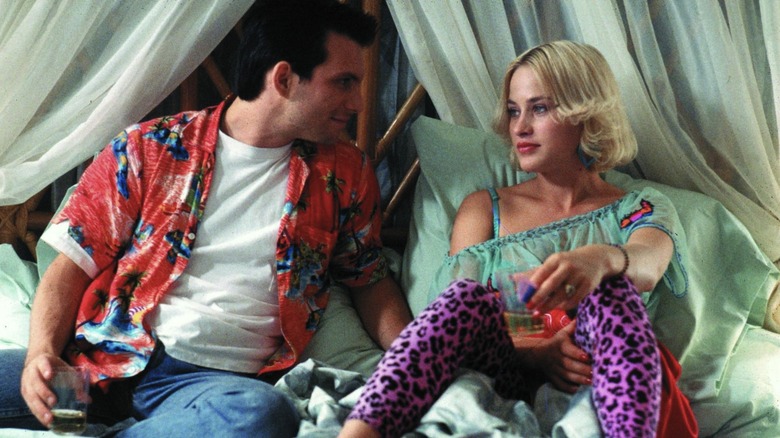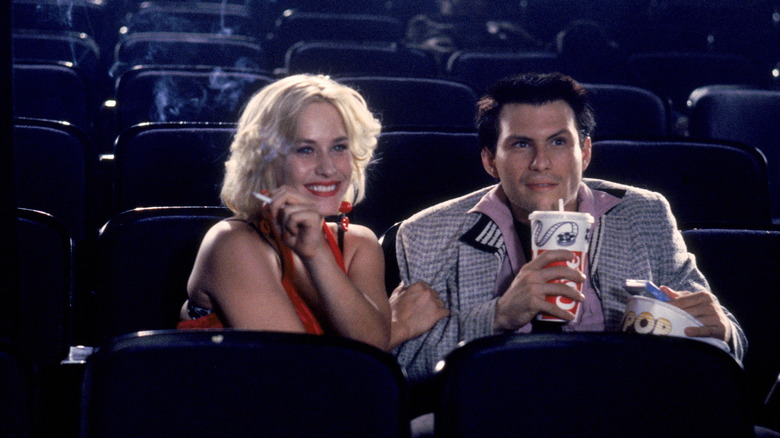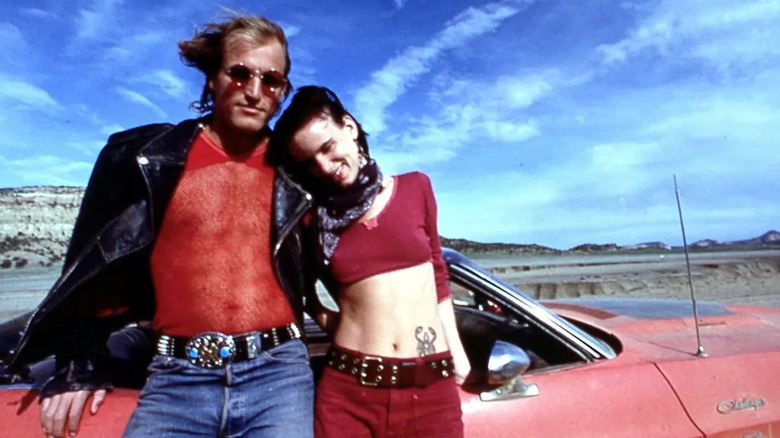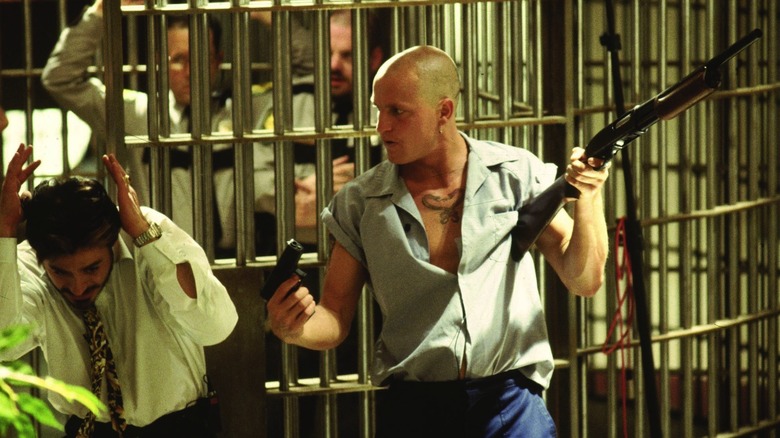
As we now know, Quentin Tarantino's movies are all set in the same fantastical cinematic universe, offering a glimpse inside the director's head. Like in the real world, anybody can die at any time in various nasty ways, but at least in the Tarantino-verse your killer will probably be jiving to some obscure '70s pop tune or engaging you in a little banter about hamburgers before pulling the trigger. It's a rich, colorful, dangerous place, laden with pop culture references, and also has a second universe within a universe. As Tarantino explained (via Esquire):
"There's the realer than real universe, alright, and all the characters inhabit that one. But then there's this movie universe. And so 'From Dusk Till Dawn,' 'Kill Bill,' they all take place in this special movie universe. So basically when the characters of 'Reservoir Dogs' or 'Pulp Fiction,' when they go to the movies, 'Kill Bill' is what they go to see. 'From Dusk Till Dawn' is what they see."
Even "Once Upon a Time in Hollywood," where Tarantino retcons history to save Sharon Tate from a grisly death at the hands of the Manson family, exists in his "realer than real" universe. Although she is based on a historical figure, I've always thought Margot Robbie's Tate has something of Alabama from "True Romance" about her. Not only is she relentlessly, blissfully good-natured, she likes to put her feet up on the seat in front at the movie theater: a totally Alabama move.
This through-line in all of Tarantino's movies makes them feel part of a consistent whole, including the films he wrote but didn't direct like "True Romance," "Natural Born Killers," and "From Dusk Till Dawn." For that, we can at least partially thank Roger Avary, whose original screenplay helped put Tarantino on the road to success in the first place.
Roger Avary's Screenplay Provided The Source Material

It's a true Hollywood underdog story: Quentin Tarantino was the video store geek who crashed the Tinseltown party on his own terms, becoming one of the most influential directors of the past three decades and living the dream for movie nerds who harbor ambitions of making films instead of just watching them.
In the audio commentary for "True Romance," Tarantino admits that he was struggling to complete a screenplay until it came to "The Open Road." He flitted around from project to project, yet couldn't get beyond the 30-page mark because there was always the next greatest idea to distract him.
"The Open Road" started life as an unfinished screenplay by his friend Roger Avary, who worked with him at a video rental store in Manhattan Beach, California. Avary remembered (via Independent):
"Quentin [...] asks me if he can finish it. A year later, it doesn't resemble my original story in the slightest -- he has, in fact, transformed it into something much more brilliant that will eventually become the bits and pieces that make up the foundations of 'True Romance,' 'Natural Born Killers,' and 'Pulp Fiction.'"
Avary's screenplay helped Tarantino break his 30-page barrier, churning out around 500 hand-written pages he described as his "great American novel that never got made." He worked with Avary to pare it down to two screenplays, "True Romance" and "Natural Born Killers." All they needed was somebody to direct one of them.
The stories vary about how Tarantino met Tony Scott. In one version, it was a Hollywood party. In another, Tarantino talked his way onto a movie set and presented the British director with the two screenplays. Scott liked them both, but there was a kicker: The precocious Tarantino said he could only pick one. Scott plumped for "True Romance," and Tarantino put the money from selling the script into "Reservoir Dogs."
True Romance, Natural Born Killers, And Pulp Fiction All Came From The Same Screenplay

Perhaps understandably, there have been some sour grapes from Roger Avary about his contribution to his former colleague's astonishing career. He moved into directing as well, albeit heavily in the shadow of Quentin Tarantino; "Killing Zoe" was a charmless crime caper that followed in the wake of "Reservoir Dogs," and "The Rules of Attraction" has something of the fractured narrative of "Pulp Fiction" without any of the Palme d'Or winner's wit or brio.
Avary has said that he considers "True Romance" to be partially his, although he received no screenwriting credit. On the flip side, Tarantino discussed the writing of the screenplay in his audio commentary for the film without mentioning Avary at all. Avary described his original story (via Independent):
"It was an early screenplay of mine about the odd couple relationship between an uptight businessman and an out-of-control hitch-hiker who travel into a hellish Midwestern town together."
From "The Open Road" we got two lovers-on-the-lam stories and some interesting parallels with "Pulp Fiction." Tarantino's original screenplay for "True Romance" was told in a non-chronological order before director Tony Scott opted for a more straightforward narrative. The suitcase full of cocaine prefigures the glowing MacGuffin in "Pulp Fiction," and there is something of Clarence and Alabama and Mickey and Mallory Knox in Pumpkin (Tim Roth) and Honey Bunny (Amanda Plummer), the first two characters we meet in Tarantino's film. Roth's Hawaiian shirt even echoes that of Christian Slater's character.
Consistent with Tarantino's magpie nature, "True Romance" and "Natural Born Killers" owe a debt of gratitude to Terrence Malick's "Badlands," although both films are very different in their approach. In the former, Hans Zimmer's score is a clear homage to Malick's film, while "Natural Born Killers" borrows the central plotline of a naive girl going on a murderous road trip with a bad-boy outsider.
True Romance And Natural Born Killers Take A Radically Different Approach

It's interesting that "True Romance" and "Natural Born Killers," two similar stories, ended up being directed by two filmmakers with styles wildly different from each other and Quentin Tarantino, while still retaining their place in the Tarantino Universe. Tony Scott's slick style compliments the action in "True Romance," harking back to the evocative arthouse inclinations of "The Hunger" rather than the gung-ho spirit of "Top Gun." His approach doesn't distract from the story in the way Tarantino's flourishes sometimes do, and even the more outlandish characters like Gary Oldman's ruthless pimp Drexl still have one foot in reality, making the peril faced by Clarence and Alabama feel very real. Similarly, while the dialogue clearly scans as Tarantino's, the performances and delivery aren't nearly as heightened.
Scott changed the structure and the end of "True Romance," letting Clarence survive, but those alterations were mild compared to "Natural Born Killers." After Tarantino sold the script and Oliver Stone came on board to direct, he worked with screenwriter David Veloz and associate producer Richard Rutowski to radically alter both the story and the tone. Tarantino's films rarely dabble in politics or social commentary beyond historical revisionism but Stone's version of his story became a caustic satire of media overkill and the burgeoning phenomenon of reality stars. Even so, traces of the Tarantino-verse remain: The cop on the trail of our psycho lovers is Jack Scagnetti (Tom Sizemore), the brother of Vincent Vega's parole officer, Seymour Scagnetti, in "Pulp Fiction."
Three decades after "Reservoir Dogs" and "True Romance," Tarantino has built a cinematic universe to rival those of Marvel and DC; you can even eat at Hawaiian-inflected fast food joints inspired by Big Kahuna Burger and buy empty Red Apple packets to keep your cigarettes in. And it all began on "The Open Road" by Roger Avary.
Read this next: 13 Tarantino Projects We Never Saw But Wish We Could've
The post True Romance Evolved Out Of The Same Project As Natural Born Killers And Pulp Fiction appeared first on /Film.
0 Comments